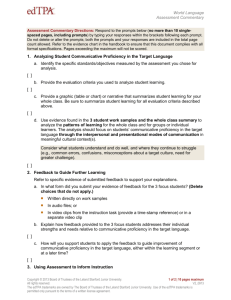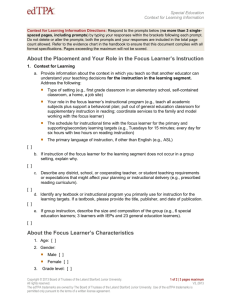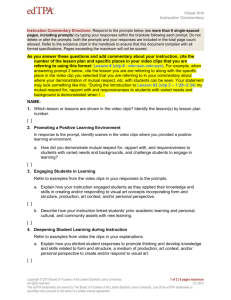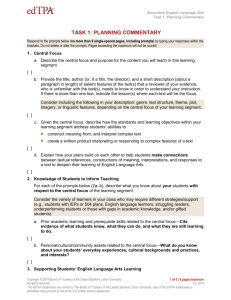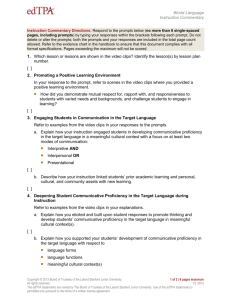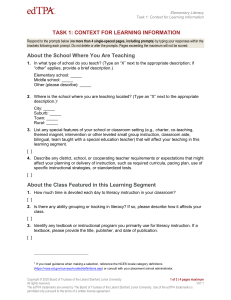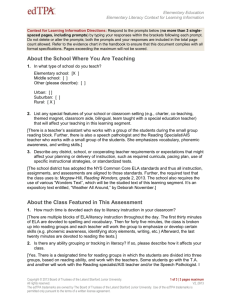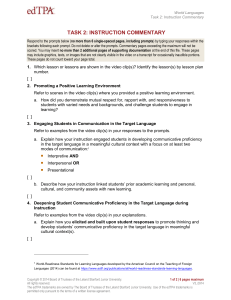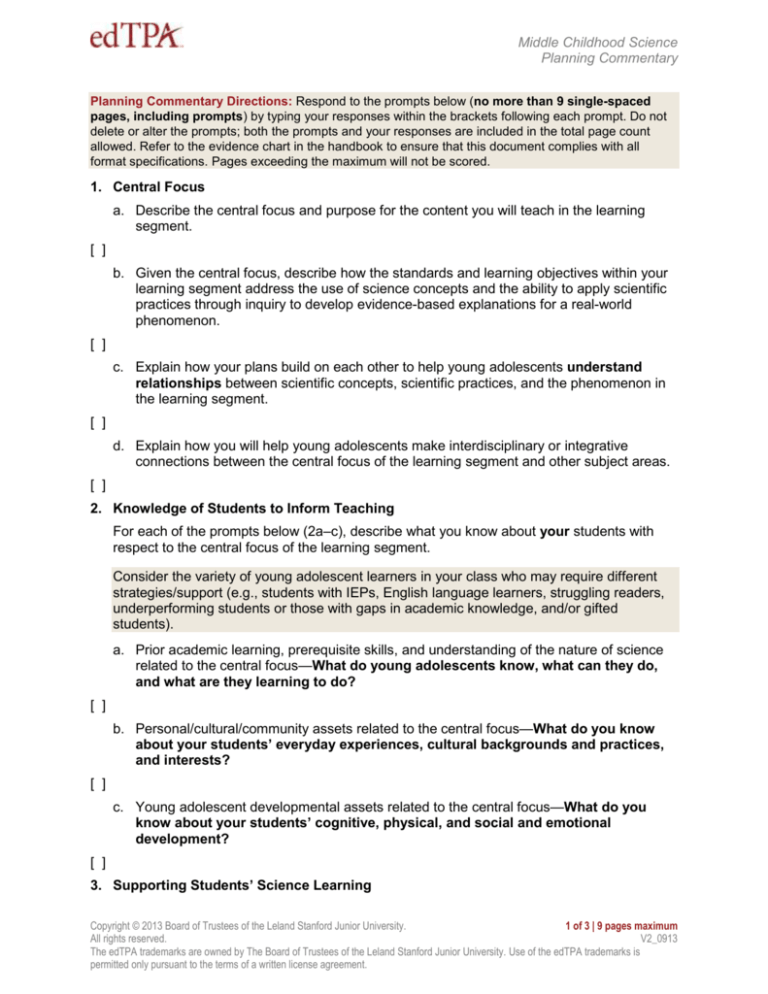
Middle Childhood Science
Planning Commentary
Planning Commentary Directions: Respond to the prompts below (no more than 9 single-spaced
pages, including prompts) by typing your responses within the brackets following each prompt. Do not
delete or alter the prompts; both the prompts and your responses are included in the total page count
allowed. Refer to the evidence chart in the handbook to ensure that this document complies with all
format specifications. Pages exceeding the maximum will not be scored.
1. Central Focus
a. Describe the central focus and purpose for the content you will teach in the learning
segment.
[ ]
b. Given the central focus, describe how the standards and learning objectives within your
learning segment address the use of science concepts and the ability to apply scientific
practices through inquiry to develop evidence-based explanations for a real-world
phenomenon.
[ ]
c. Explain how your plans build on each other to help young adolescents understand
relationships between scientific concepts, scientific practices, and the phenomenon in
the learning segment.
[ ]
d. Explain how you will help young adolescents make interdisciplinary or integrative
connections between the central focus of the learning segment and other subject areas.
[ ]
2. Knowledge of Students to Inform Teaching
For each of the prompts below (2a–c), describe what you know about your students with
respect to the central focus of the learning segment.
Consider the variety of young adolescent learners in your class who may require different
strategies/support (e.g., students with IEPs, English language learners, struggling readers,
underperforming students or those with gaps in academic knowledge, and/or gifted
students).
a. Prior academic learning, prerequisite skills, and understanding of the nature of science
related to the central focus—What do young adolescents know, what can they do,
and what are they learning to do?
[ ]
b. Personal/cultural/community assets related to the central focus—What do you know
about your students’ everyday experiences, cultural backgrounds and practices,
and interests?
[ ]
c. Young adolescent developmental assets related to the central focus—What do you
know about your students’ cognitive, physical, and social and emotional
development?
[ ]
3. Supporting Students’ Science Learning
Copyright © 2013 Board of Trustees of the Leland Stanford Junior University.
1 of 3 | 9 pages maximum
All rights reserved.
V2_0913
The edTPA trademarks are owned by The Board of Trustees of the Leland Stanford Junior University. Use of the edTPA trademarks is
permitted only pursuant to the terms of a written license agreement.
Middle Childhood Science
Planning Commentary
Respond to prompts 3a–c below. To support your explanations, refer to the instructional
materials and lesson plans you have included as part of Task 1. In addition, use principles
from research and/or theory, including young adolescent development, to support
your explanations.
a. Explain how your understanding of your students’ prior academic learning and
personal/cultural/community/developmental assets (from prompts 2a–c above) guided
your choice or adaptation of learning tasks and materials.
[ ]
b. Describe and justify why your instructional strategies and planned supports are
appropriate for the whole class, individuals, and groups of young adolescents with
specific learning needs.
Consider young adolescents with IEPs, English language learners, struggling readers,
underperforming students or those with gaps in academic knowledge, and/or gifted
students needing greater support or challenge.
[ ]
c. Describe common preconceptions (based on prior academic learning and experiences)
within your central focus and how you will identify and address them.
[ ]
4. Supporting Science Development Through Language
a. Language Function. Identify one language function from the list below, essential for
young adolescents to learn within your central focus.
Analyze
Explain
Interpret
Justify with evidence
[ ]
b. Identify a key learning task from your plans that provides young adolescents with
opportunities to practice using the language function. Identify the lesson in which the
learning task occurs. (Give lesson day/number.)
[ ]
c. Additional Language Demands. Given the language function and learning task
identified above, describe the following associated language demands (written or oral)
young adolescents need to understand and/or use:
Vocabulary and/or symbols
Plus at least one of the following:
Syntax
Discourse
Consider the range of young adolescents’ understandings of the language function and
other language demands—What do students already know, what are they struggling
with, and/or what is new to them?
[ ]
d. Language Supports
Copyright © 2013 Board of Trustees of the Leland Stanford Junior University.
2 of 3 | 9 pages maximum
All rights reserved.
V2_0913
The edTPA trademarks are owned by The Board of Trustees of the Leland Stanford Junior University. Use of the edTPA trademarks is
permitted only pursuant to the terms of a written license agreement.
Middle Childhood Science
Planning Commentary
Refer to your lesson plans and instructional materials as needed in your response to this
prompt.
Describe the instructional supports (during and/or prior to the learning task) that help
young adolescents understand and successfully use the language function and
additional language demands identified in prompts 4a–c.
[ ]
5. Monitoring Student Learning
In response to the prompts below, refer to the assessments you will submit as part of the
materials for Task 1.
a. Describe how your planned formal and informal assessments will provide direct
evidence of young adolescents’ understanding of science concepts, the phenomenon,
the nature of science, and the application of scientific practices through inquiry
throughout the learning segment.
[ ]
b. Explain how the design or adaptation of your planned assessments allows young
adolescents with specific needs to demonstrate their learning.
Consider all students, including young adolescents with IEPs, English language
learners, struggling readers, underperforming students or those with gaps in academic
knowledge, and/or gifted students.
[ ]
Copyright © 2013 Board of Trustees of the Leland Stanford Junior University.
3 of 3 | 9 pages maximum
All rights reserved.
V2_0913
The edTPA trademarks are owned by The Board of Trustees of the Leland Stanford Junior University. Use of the edTPA trademarks is
permitted only pursuant to the terms of a written license agreement.

